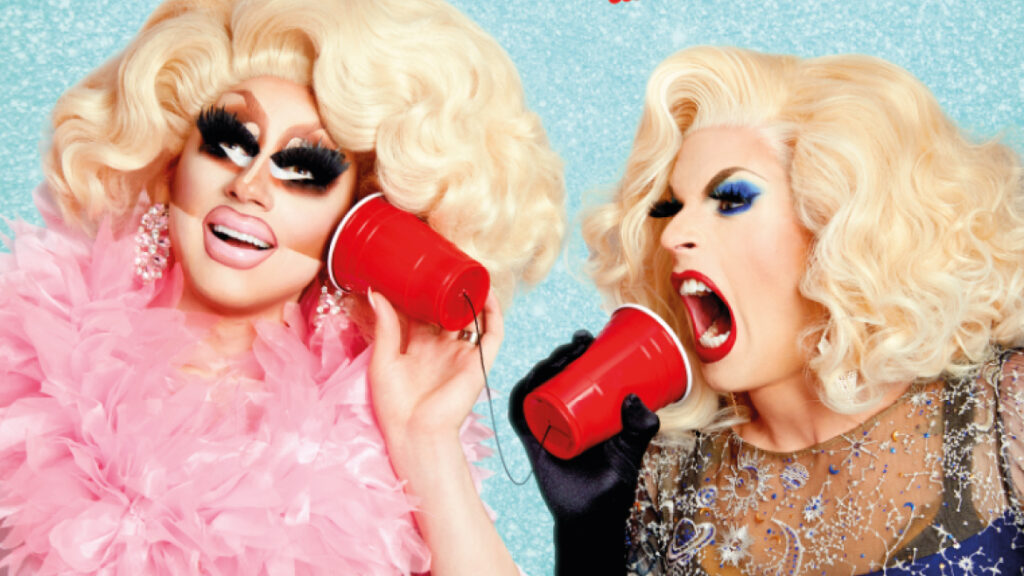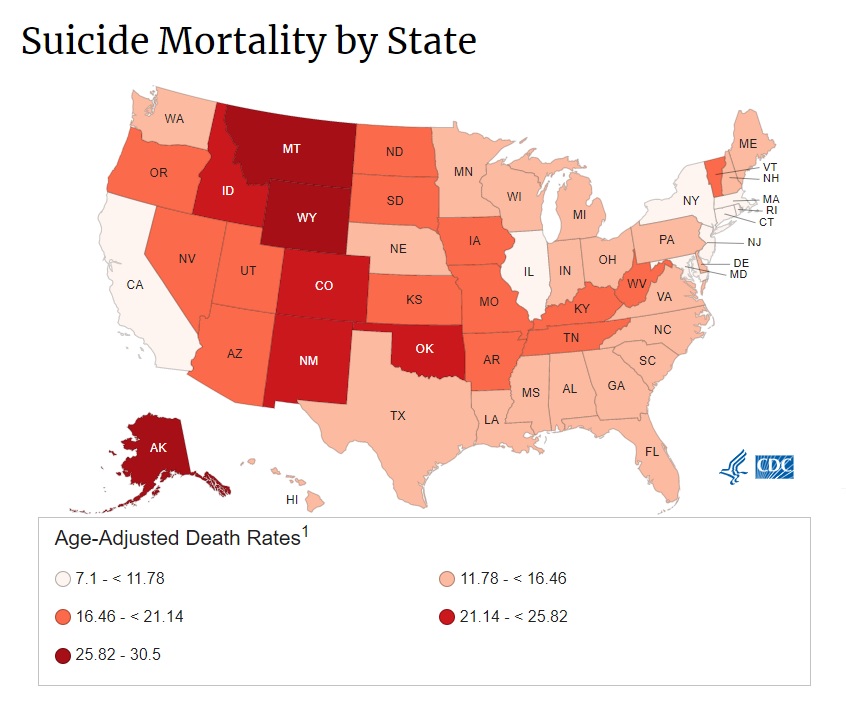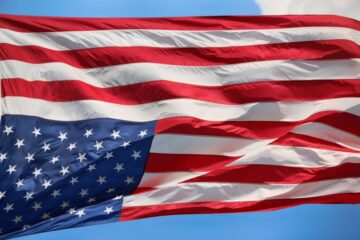America’s Latest Epidemic: Suicide
When I was considering suicide, a rare cause for laughter was UNHhhh, starring drag queens Trixie Mattel and Katya Zamolodchikova. They met and competed on RuPaul’s Drag Race, season seven. The notoriety they achieved online however has far eclipsed their respective runs on Drag Race. The popular YouTube series, edited by fan favorites Ron Hill and Jeff Maccubbin, has shot seven seasons.
Trixie calls it “a show where we talk about… whatever we want.”
“Because it’s our show,” adds Katya, “and not yours.”

From Trixie and Katya’s live podcast, “The Bald and the Beautiful“
Six years later I’m still alive, and still very much a fan of these queens. It never spoiled the show to have watched it in conjunction with arranging my suicide. In fact it provided relief from intrusive thoughts persuading me to die before I ruined people’s lives. I wondered though if Trixie and Katya knew what a lifeline their comedy is for other queers (they do). When each passing second is unbearable, ten minutes of uninterrupted humor can be a miracle.
Known and loved for her unfiltered demeanor and shame-obliterating candor, Katya Zamolodchikova isn’t shy about her history of substance abuse and suicidal thoughts. She is the yin to Trixie’s coarse yet caring yang, and she’s wanted an episode about suicide since the show began. The producers at World of Wonder on the other hand are not too keen on the idea. “I think, wouldn’t you love to hear us rattle off a list of the most popular methods of suicide?” Katya told Billboard in 2018 before adding that she doesn’t encourage the act.
“Yeah, we do get to a place where it’s like, maybe there’s not a safe way for us to joke about something,” Trixie told The Paris Review in 2017.
“I disagree,” Katya said in the same interview. “I think you can safely joke about anything. Mostly. Like, except … well, we would never do an episode on racism.”
World of Wonder’s censorship left a bad taste in my mouth. If drag queens Trixie and Katya can’t share their feelings on suicide in a West Hollywood film studio, what hopes does a straight person have living in say, rural Wyoming?
The Suicide Belt
The Sun Belt describes the Desert Southwest; the Bible Belt, the flat and endless Plains. The Rust Belt consists of America’s former steel mill towns along the southern edge of the Great Lakes. The nation’s newest belt is cinched around the Mountain West, mainly Colorado, Utah, Montana, and Wyoming. In these states, suicide rates are among the country’s highest. Police in Casper, Wyoming, respond to more calls about suicide than shoplifting. Six locals have died since 2022 started.

Statistics published by the Centers for Disease Control, 2020.
The Suicide Belt isn’t like the rest. Instead of religion, outsourced industry, or the sun, the oppressor here is life itself—specifically, the lifestyle.
“Wyoming is very much deeply indoctrinated in what I would describe as cowboy culture,” says Casper Police Chief Keith McPheeters. “There’s a cowboy code of ethics that really embodies, ‘Whatever the world throws at me, I can find my way through it.’ But suicide and mental health are things you may not be able to just ‘pull yourself up by the bootstraps’ and see yourself through.”
Chief McPheeters works closely with Mr. Lance Neiberger, chair of the Natrona County Suicide Loss Support Group. Partnered with the Casper Police Department, they focus their efforts on curtailing the region’s record-breaking suicide rates. ABC reporter Trevor Ault recently interviewed Mr. Neiberger.
“We’re all in the ‘Cowboy Up’ attitude, y’know. ‘Real men don’t cry. Real men don’t have problems.’”
Lance had a son named Lyle, born just one year and six months before me. Lyle died by suicide in 2006. He lives now only in Lance’s head. When asked if he subscribed to the cowboy mentality, his basset hound-eyes veered from Ault’s gaze.
“Y’know, it’s [bred] into me. We all have problems,” he said, his smile resigned. “We all have something go wrong.”
Yet Another Epidemic
“It is dark and sometimes invisible,” began Trevor Ault’s report; “this epidemic of suicide is a major public health concern and is among the leading causes of death in the United States.”
Why put it that way, I thought (perhaps a reference to seminal depression memoir Darkness Visible by William Styron?). If we’re calling it an epidemic, we should make clear it isn’t viral, bacterial, or even strictly psychological. If it were, it would be diagnosable and then treatable. Indeed, people are investigating. Shayla Love wrote an article for Vice called “The Chilling Mystery of High-Altitude Suicides” in 2019. Her subheader: “U.S. counties above 4,000 feet have twice the suicides as counties at 2,000 feet. Is it because there’s less oxygen in the air, or is something else going on?”
“One thing that these states have in common is high elevations. In 2011, a handful of scientists from Utah put forth a provocative theory: that the high altitudes are contributing to the high suicide rates. They said that a lack of oxygen can lead to hypoxia, or oxygen deprivation, and affect fundamental processes of the brain, like the production of the neurotransmitter serotonin, which is thought to play a key role in mood. They think it could also potentially affect the functioning of depression medications like SSRIs.”
This theory drew ire from those who insist more pressing issues like poverty, failing health, zero healthcare and xenophobia deserve more attention. In the Suicide Belt, one major contributing factor is relative isolation. Wyoming is one of the least populated states, and the presence of mental health professionals is even thinner. Liquor and drugs are plentiful. Substance abuse is rampant. Guns outnumber people three to one. Help, if wanted, is hard to find.
A Temporary Solution
To pool strained resources, a nationwide service recently launched to connect anyone experiencing a psychological crisis with a counselor. NPR’s Rhitu Chatterjee reports:
“Modeled after 911, the new three-digit 988 Suicide & Crisis Lifeline is designed to be a memorable and quick number that connects people who are suicidal or in any other mental health crisis to a trained mental health professional.”
I think, once again, we’re ignoring the obvious. We seem to be missing the Aokigahara Forest for the trees. Wyoming and Mountain West make up some of the most beautiful landscapes in the country, yet the United States has become a place wherein one’s prospects can get so bleak and with so little effort, that to keep living seems a moot point. What’s the training manual have to say about that? ABC Reporter Trevor Ault ended his broadcast in praise of this new service. “988 is being touted as a one-stop shop for anyone experiencing a mental health crisis,” he said. I can’t help but wonder: is that the best we can do?
When I was considering suicide, 988 did not exist. Despite that, I can’t say I’d have called. Knowing the government’s hollow response to AIDS, COVID-19, and now monkeypox, my trust in government health initiatives is nil. At my partner’s insistence I sought help at a local crisis center, a luxury available to shockingly few people. While I was fortunate enough to get treatment, the question still remains. Why are legislators spending extravagantly to prevent suicide rather than make American life desirable enough to live? Is 988 the best we can do?
For now, it has to be.
988 is now live and accessible. For immediate local help, call the San Francisco Suicide Prevention anytime at (415) 781-0500.









